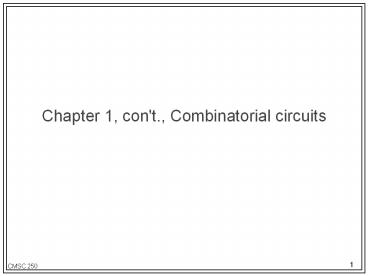Chapter 1, con't., Combinatorial circuits - PowerPoint PPT Presentation
1 / 17
Title:
Chapter 1, con't., Combinatorial circuits
Description:
Chapter 1, con't., Combinatorial circuits – PowerPoint PPT presentation
Number of Views:149
Avg rating:3.0/5.0
Title: Chapter 1, con't., Combinatorial circuits
1
Chapter 1, con't., Combinatorial circuits
2
Basic logic gates
- An and gate
- An or gate
- A not gate
3
Discrete StructuresCMSC 250Lecture 6
4
Combining determining I/O relationship
- From a circuit to a Boolean formula
- p ? (q r)
5
Draw a circuit for
- p, q r are inputs.
- Simplify before building the circuit.
p q r output
1 1 1 1
1 1 0 1
1 0 1 0
1 0 0 1
0 1 1 0
0 1 0 0
0 0 1 0
0 0 0 0
6
Number conversions
- Different number system bases are used when
convenient - some commonly-used bases are 10 (decimal), 2
(binary), 8 (octal), 16 (hexadecimal) - the base tells how many different numerals are
used - the base also determines the value of each place
- Conversions from anything to base 10
- use the definition of the number system
- Conversions from base 10 to anything
- use repeated integer division
7
Addition of binary numbers
- Carry if the number would be too large for the
number system- if it is greater than 1
1001
10
1001
11
1011
10
1101
111
8
Discrete StructuresCMSC 250Lecture 7
9
Addition of octal and hexadecimal numbers
- Carry if the number would be too large for the
number system (larger than 7 or 15)
7238
128
2658
338
ABC16
1216
CDE16
ED16
10
Two's complement
- To represent negative values in binary
- Find the binary equivalent of the absolute value.
- Pad on the left to completely fill the bits in
the specified bit width - Switch all of the 1's to 0's and 0's to 1's.
- Add 1 to the result.
- Example find the 8-bit two's complement
representation of -43 - 4310 1010112
- 001010112
- 110101002
- 110101012 -4310
11
Using a circuit for adding two bits
input
output
p q carry sum
0 0 0 0
0 1 0 1
1 0 0 1
1 1 1 0
- Write as a logic expression
- Translate to circuits
12
Half adder
- p and q are binary values (1 bit each)
- sum (p ? q) (p q)
- carry (p q)
13
Full adder (for three bits)
- p, q, and r are binary digits
- p q r produces a sum value and a carry value
14
Parallel adders
- Chain these half adders and full adders together
for multi-bit addition - X1X2X3 Y1Y2Y3 CA1A2A3
X3
Y3
X2
Y2
X1
Y1
15
Discrete StructuresCMSC 250Lecture 8
16
Draw a circuit for
a b c output
0 0 0 0 0 0 0 0 0
0 0 1 0 0 0 0 0 1
0 1 0 0 0 0 1 0 0
0 1 1 0 0 1 0 0 1
1 0 0 0 1 0 0 0 0
1 0 1 0 1 1 0 0 1
1 1 0 1 0 0 1 0 0
1 1 1 1 1 0 0 0 1
17
Topic not covered
- Simplifying circuits- there are techniques which
exist (which are complex).































